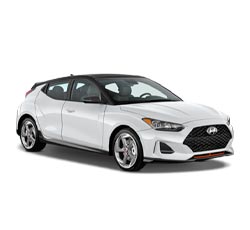2021 Hyundai Veloster Trim Levels with Comparisons & Configurations.
The 2021 Hyundai Veloster offers something special to drivers of all levels - from first-time drivers wanting comfort features or experienced ones in need of performance. Those with discerning tastes have three trim level options available to compare: 2.0 vs Premium at base levels; Turbo & R-Spec plus Ultimate as top tiers! In this article we examine what sets these models apart so you can make an informed decision on which series is perfect for you – revealing included features per option and price ranges too.
Compare the Veloster 2.0 vs 2.0 Premium Trims. What is the difference?
The Veloster is powered by a lively 2.0-liter four cylinder unit, capable of producing 147 horsepower and 132 pound-feet of torque - providing an impressive punch for drivers to enjoy. Standard on both models is front wheel driving with manual transmission available as standard equipment in the base model trim; those wishing for extra convenience may prefer the automatic only format that comes with the Premium variant. Efficiency ratings suggest these powerful vehicles can still be surprisingly thrifty when it comes to fuel economy: 25/33 mpg (manual) or 27/34 mpg (automatic).
While there isn't any all-wheel drive available on the Veloster, there is something called Drive Mode. This program comes with three different settings so that drivers can make adjustments to how their vehicles handle themselves. Normal is the default mode that offers a nice blend of qualities. Eco is the mode to choose whenever efficiency wants to be prioritized. Sport mode gives the Veloster a more exciting ride, with greater responsiveness and feedback through the steering wheel.
The Veloster 2.0 and 2.0 Premium offer distinctive wheels that set them apart from one another - the standard version rolling on 17-inch alloy, while its premium counterpart has 18-inches of glimmering metal encasing each corner for a truly eye catching look all around town! Both trims have excellent exterior amenities such as projector headlights with auto turn on capabilities, LED Daytime Running Lights to ensure safety when driving after dark and side mirrors featuring heated elements so they don't freeze over during cold morning commutes. Plus you'll find rear spoilers which provide an aerodynamic boost in performance along with tinted glass plus special single speed wipers specifically designed for the hatchback's vertical rear window; although only available on the higher trimmed model is a panoramic sunroof adding elegance to your ride no matter where it takes you.
Step into the cabin of a 2.0 and experience cloth seating, with an air conditioning system controlled by your fingertips alone. Upgrade to Premium for a luxurious ride - heated seats will keep you warm no matter where the journey leads, while leather bolsters provide extra comfort when shifting gears from its leather-wrapped steering wheel and shift knob. And auto temperature control ensures both convenience and clarity - fogged windows are never part of this equation.
For anyone interested in technology, these next differences are sure to be significant. Out of these two lower trims of the Hyundai Veloster, only the 2.0 Premium has an eight-inch touchscreen, SiriusXM Satellite Radio, voice recognition, wireless charging, and Blue Link connectivity. The 2.0 does have a seven-inch touchscreen, smartphone compatibility, and Bluetooth, but it lacks the more high-end components. The Infinity audio system on the Premium comes with eight speakers, to include a subwoofer, and Blue Link allows people to access their vehicles remotely from a mobile app. They can do things like start their engines, unlock the doors, and pinpoint vehicle location from their smartphones.
The Veloster has your back when it comes to keeping you safe on the roads with its impressive suite of advanced safety features. From vehicle stability systems and anti-lock brakes for great maneuverability, various airbags around the cabin in case things take a bad turn, plus driver assistance technology like forward collision avoidance assist and lane keeping aid – let’s just say they have thought of everything! Although even at entry level trims there are some specialized ‘bonus tech’ such as blind spot mirrors that can be found higher up (2.0 Premium). Rest assured that wherever your journey may take you, Hyundai got you covered.
Compare the Veloster 2.0 Premium vs Turbo R-Spec. What is the difference?
Step inside the Turbo R-Spec and experience next level performance with a powerful 1.6 liter turbocharged engine that roars to life, producing an impressive 201 horses and 195 pound-feet of torque! Active Sound Design lets drivers customize their driving soundtrack while they tackle tight corners using sport tuned steering - all enhanced by high performing tires for maximum handling ability. Quick shifts from the six speed manual transmission powered B&M Racing Sport Shifter will make every journey even more exhilarating – although it may cost you slightly in efficiency at 26/33 mpg instead of 27/34 mpg compared to standard trims.
On the outside of the Veloster Turbo R-Spec, there are LED projector headlights. LEDs are also used in the rear taillights. Unlike the 2.0 Premium, the Turbo R-Spec does not have a sunroof.
Inside the Turbo R-Spec, there are some sportier elements that some people will appreciate. For example, it has special R-Spec cloth seats, a unique shift knob, and alloy pedals. Its rear seatback has adjustable head restraints, and it has the same type of infotainment system as the one incorporated into the 2.0 Premium. A few notable things are that the Turbo R-Spec doesn't have the wireless charging pad and automatic temperature control that the 2.0 Premium has.
When comparing the Turbo R-Spec to the 2.0 Premium, there are no changes in terms of safety. Potential customers should consider this a positive thing, since it means that the 2.0 Premium, as the second-lowest Veloster trim, has a full array of advanced components.
Compare the Turbo R-Spec vs Turbo. What is the difference?
The Hyundai Veloster Turbo brings a heightened performance and efficiency to the driving experience. With its seven-speed EcoShift dual clutch transmission, all-season tires, heated front seats with power lumbar adjustable driver's seat, leather wrapped shift knob and steering wheel as well as automatic temperature control and wireless charging capabilities - it has everything you need for an efficient yet luxurious ride this winter!
Compare the Turbo vs Turbo Ultimate. What is the difference?
If you're looking for an eye-catching and luxurious ride, the Hyundai Veloster Turbo Ultimate should be at the top of your list. Combining a striking two-tone roof with leather seating throughout its cabin, this trim offers unbeatable sophistication without breaking the bank - all for just over $28k! Plus, features like heated front seats and adjustable head restraints in rear make it truly unique among other trims. With both style and comfort rolled into one great vehicle package, you won't want to miss out on this model.
The Turbo Ultimate is an innovative car customized with features to make the driving experience easier and safer. It has sophisticated navigation, HD Radio, a Heads-Up Display which projects specific vehicle information onto the windshield, Smart Cruise Control that adjusts speed based on other vehicles' movements and even a forward collision avoidance system capable of detecting pedestrians! For added convenience in any weather conditions it also includes rain-sensing wipers so you can keep your eyes firmly focused on where you're going.
Final Thoughts
While all five trims of the 2021 Hyundai Veloster are attractive, some stand out more than others. From a technology standpoint, the lower trim doesn't match up with the others since it has the smaller touchscreen and lacks SiriusXM Satellite Radio and voice recognition. From a performance perspective, the top three trims have an advantage because they're powered by turbocharged engines. Since the difference between 147 and 201 horsepower is significant, the turbo versions are recommended.
Once the choices are narrowed down to the top three Veloster trims, one has to decide whether a manual or dual-clutch transmission is better. For most drivers, the dual-clutch is going to win this matchup every time.
Between the Turbo and Turbo Ultimate trims, there are more similarities than differences. If a customer has the budget to absorb the higher costs of the Turbo Ultimate and wants upscale touches like leather seats and navigation, than it's certainly the right choice. However, the Hyundai Veloster Turbo is going to be the trim most recommended. It's more affordable, and it still comes with many advanced technological components and convenient amenities.
• 2021 Hyundai Accent Trims
• 2021 Hyundai Elantra Trims
• 2021 Hyundai Kona Trims
• 2021 Hyundai Palisade Trims
• 2021 Hyundai Santa Fe Trims
• 2021 Hyundai Sonata Trims
• 2021 Hyundai Sonata Hybrid Trims
• 2021 Hyundai Tucson Trims
• 2021 Hyundai Veloster Trim Configurations
• 2021 Hyundai Venue Trims


